Key Performance Indicators for Radiology in Healthcare Settings
VerifiedAdded on 2022/09/17
|6
|1117
|21
Report
AI Summary
This report examines the key performance indicators (KPIs) essential for the successful operation of diagnostic radiology departments in two distinct healthcare settings: communicable disease centers and oncology hospitals. For communicable disease centers, the report emphasizes clinical performance, including the accurate interpretation of images to reduce the spread of diseases, and patient quality and safety, focusing on efficient appointment scheduling and pre-appointment information management to minimize waiting times and potential exposure. In oncology hospitals, the report highlights the importance of effective healthcare facilities, including the use of advanced imaging technologies and staff training to ensure accurate diagnosis and treatment of cancer patients. Additionally, it underscores the significance of resource utilization and productivity, such as the efficient use of imaging equipment and the training of staff to enhance equipment productivity, ultimately contributing to improved patient outcomes and the overall success of the radiology department. The report also includes a list of references used in the report.
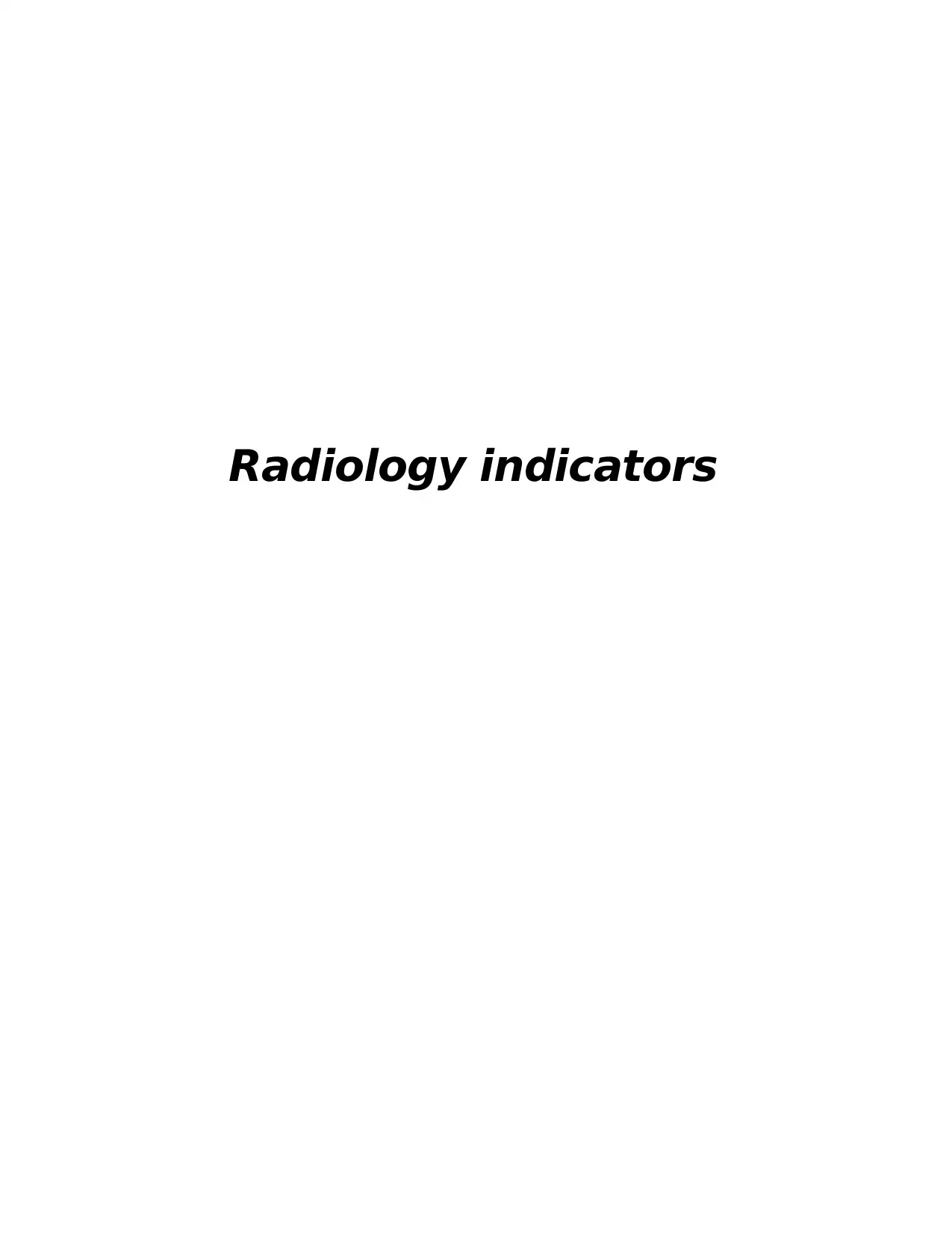
Radiology indicators
Paraphrase This Document
Need a fresh take? Get an instant paraphrase of this document with our AI Paraphraser

1
Table of Contents
Key performance indicator of running a successful diagnostic radiology department in
communicable disease centre..........................................................................................................2
Key performance indicator of running a successful diagnostic radiology department in Oncology
hospital.............................................................................................................................................3
References........................................................................................................................................5
Table of Contents
Key performance indicator of running a successful diagnostic radiology department in
communicable disease centre..........................................................................................................2
Key performance indicator of running a successful diagnostic radiology department in Oncology
hospital.............................................................................................................................................3
References........................................................................................................................................5
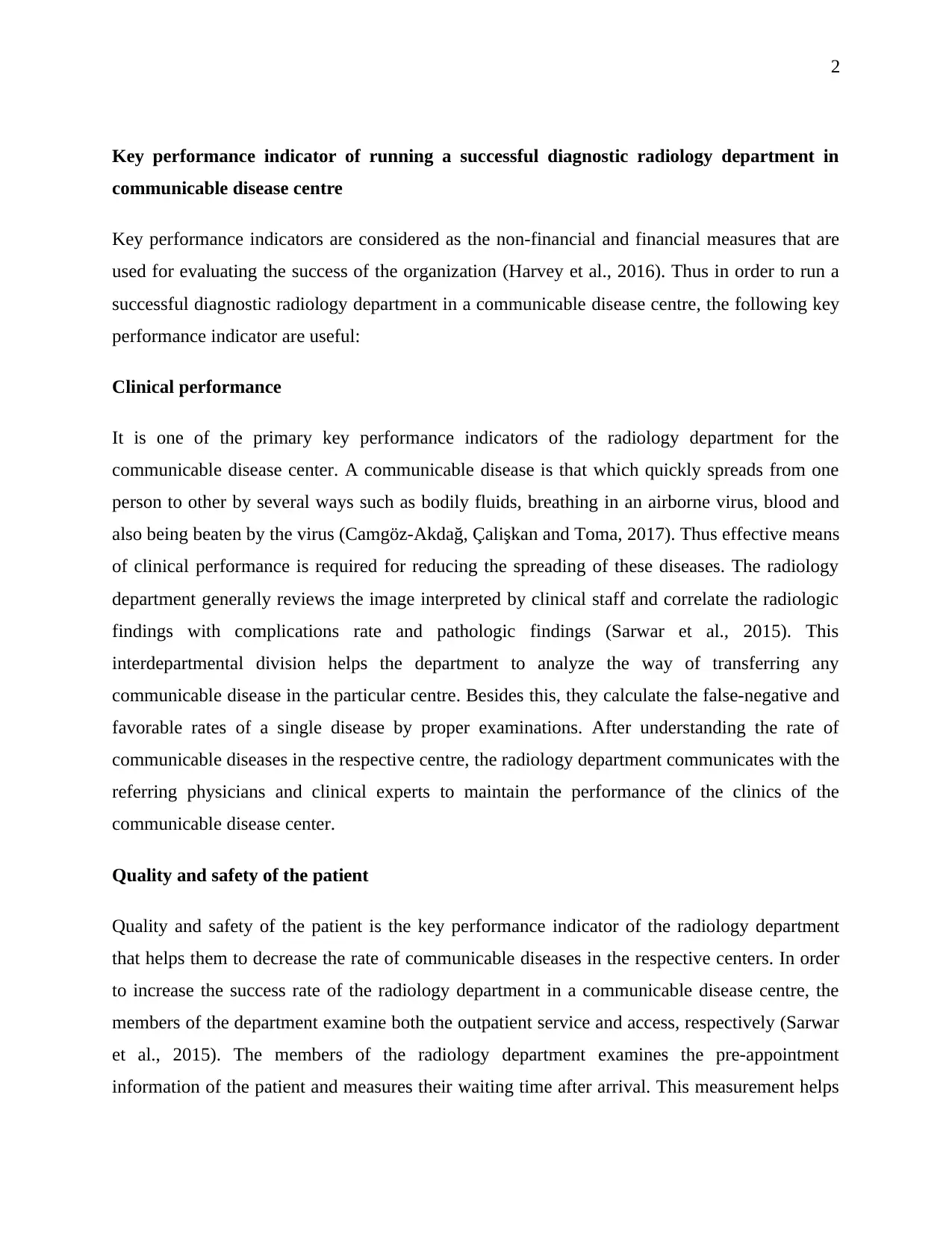
2
Key performance indicator of running a successful diagnostic radiology department in
communicable disease centre
Key performance indicators are considered as the non-financial and financial measures that are
used for evaluating the success of the organization (Harvey et al., 2016). Thus in order to run a
successful diagnostic radiology department in a communicable disease centre, the following key
performance indicator are useful:
Clinical performance
It is one of the primary key performance indicators of the radiology department for the
communicable disease center. A communicable disease is that which quickly spreads from one
person to other by several ways such as bodily fluids, breathing in an airborne virus, blood and
also being beaten by the virus (Camgöz-Akdağ, Çalişkan and Toma, 2017). Thus effective means
of clinical performance is required for reducing the spreading of these diseases. The radiology
department generally reviews the image interpreted by clinical staff and correlate the radiologic
findings with complications rate and pathologic findings (Sarwar et al., 2015). This
interdepartmental division helps the department to analyze the way of transferring any
communicable disease in the particular centre. Besides this, they calculate the false-negative and
favorable rates of a single disease by proper examinations. After understanding the rate of
communicable diseases in the respective centre, the radiology department communicates with the
referring physicians and clinical experts to maintain the performance of the clinics of the
communicable disease center.
Quality and safety of the patient
Quality and safety of the patient is the key performance indicator of the radiology department
that helps them to decrease the rate of communicable diseases in the respective centers. In order
to increase the success rate of the radiology department in a communicable disease centre, the
members of the department examine both the outpatient service and access, respectively (Sarwar
et al., 2015). The members of the radiology department examines the pre-appointment
information of the patient and measures their waiting time after arrival. This measurement helps
Key performance indicator of running a successful diagnostic radiology department in
communicable disease centre
Key performance indicators are considered as the non-financial and financial measures that are
used for evaluating the success of the organization (Harvey et al., 2016). Thus in order to run a
successful diagnostic radiology department in a communicable disease centre, the following key
performance indicator are useful:
Clinical performance
It is one of the primary key performance indicators of the radiology department for the
communicable disease center. A communicable disease is that which quickly spreads from one
person to other by several ways such as bodily fluids, breathing in an airborne virus, blood and
also being beaten by the virus (Camgöz-Akdağ, Çalişkan and Toma, 2017). Thus effective means
of clinical performance is required for reducing the spreading of these diseases. The radiology
department generally reviews the image interpreted by clinical staff and correlate the radiologic
findings with complications rate and pathologic findings (Sarwar et al., 2015). This
interdepartmental division helps the department to analyze the way of transferring any
communicable disease in the particular centre. Besides this, they calculate the false-negative and
favorable rates of a single disease by proper examinations. After understanding the rate of
communicable diseases in the respective centre, the radiology department communicates with the
referring physicians and clinical experts to maintain the performance of the clinics of the
communicable disease center.
Quality and safety of the patient
Quality and safety of the patient is the key performance indicator of the radiology department
that helps them to decrease the rate of communicable diseases in the respective centers. In order
to increase the success rate of the radiology department in a communicable disease centre, the
members of the department examine both the outpatient service and access, respectively (Sarwar
et al., 2015). The members of the radiology department examines the pre-appointment
information of the patient and measures their waiting time after arrival. This measurement helps
⊘ This is a preview!⊘
Do you want full access?
Subscribe today to unlock all pages.

Trusted by 1+ million students worldwide
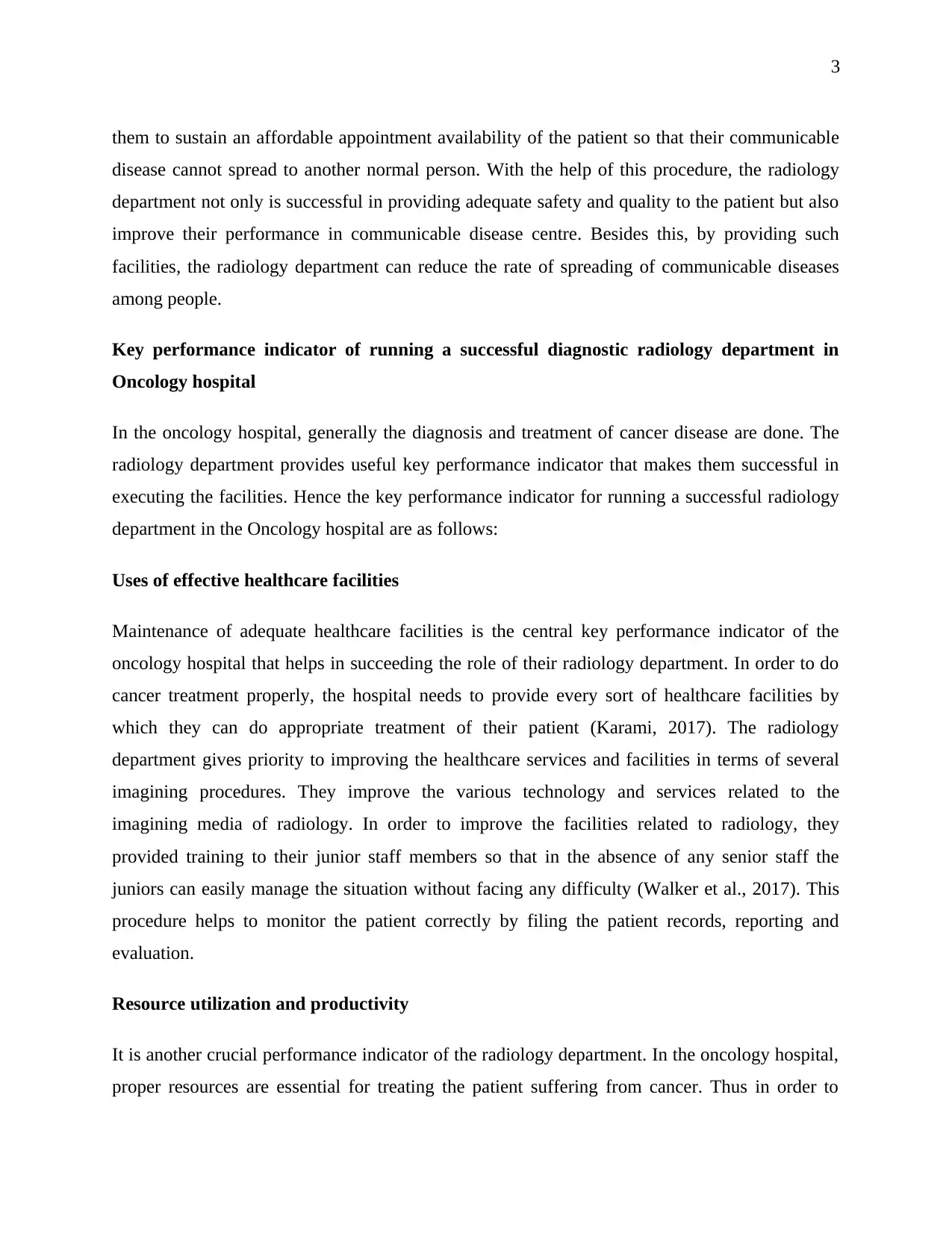
3
them to sustain an affordable appointment availability of the patient so that their communicable
disease cannot spread to another normal person. With the help of this procedure, the radiology
department not only is successful in providing adequate safety and quality to the patient but also
improve their performance in communicable disease centre. Besides this, by providing such
facilities, the radiology department can reduce the rate of spreading of communicable diseases
among people.
Key performance indicator of running a successful diagnostic radiology department in
Oncology hospital
In the oncology hospital, generally the diagnosis and treatment of cancer disease are done. The
radiology department provides useful key performance indicator that makes them successful in
executing the facilities. Hence the key performance indicator for running a successful radiology
department in the Oncology hospital are as follows:
Uses of effective healthcare facilities
Maintenance of adequate healthcare facilities is the central key performance indicator of the
oncology hospital that helps in succeeding the role of their radiology department. In order to do
cancer treatment properly, the hospital needs to provide every sort of healthcare facilities by
which they can do appropriate treatment of their patient (Karami, 2017). The radiology
department gives priority to improving the healthcare services and facilities in terms of several
imagining procedures. They improve the various technology and services related to the
imagining media of radiology. In order to improve the facilities related to radiology, they
provided training to their junior staff members so that in the absence of any senior staff the
juniors can easily manage the situation without facing any difficulty (Walker et al., 2017). This
procedure helps to monitor the patient correctly by filing the patient records, reporting and
evaluation.
Resource utilization and productivity
It is another crucial performance indicator of the radiology department. In the oncology hospital,
proper resources are essential for treating the patient suffering from cancer. Thus in order to
them to sustain an affordable appointment availability of the patient so that their communicable
disease cannot spread to another normal person. With the help of this procedure, the radiology
department not only is successful in providing adequate safety and quality to the patient but also
improve their performance in communicable disease centre. Besides this, by providing such
facilities, the radiology department can reduce the rate of spreading of communicable diseases
among people.
Key performance indicator of running a successful diagnostic radiology department in
Oncology hospital
In the oncology hospital, generally the diagnosis and treatment of cancer disease are done. The
radiology department provides useful key performance indicator that makes them successful in
executing the facilities. Hence the key performance indicator for running a successful radiology
department in the Oncology hospital are as follows:
Uses of effective healthcare facilities
Maintenance of adequate healthcare facilities is the central key performance indicator of the
oncology hospital that helps in succeeding the role of their radiology department. In order to do
cancer treatment properly, the hospital needs to provide every sort of healthcare facilities by
which they can do appropriate treatment of their patient (Karami, 2017). The radiology
department gives priority to improving the healthcare services and facilities in terms of several
imagining procedures. They improve the various technology and services related to the
imagining media of radiology. In order to improve the facilities related to radiology, they
provided training to their junior staff members so that in the absence of any senior staff the
juniors can easily manage the situation without facing any difficulty (Walker et al., 2017). This
procedure helps to monitor the patient correctly by filing the patient records, reporting and
evaluation.
Resource utilization and productivity
It is another crucial performance indicator of the radiology department. In the oncology hospital,
proper resources are essential for treating the patient suffering from cancer. Thus in order to
Paraphrase This Document
Need a fresh take? Get an instant paraphrase of this document with our AI Paraphraser
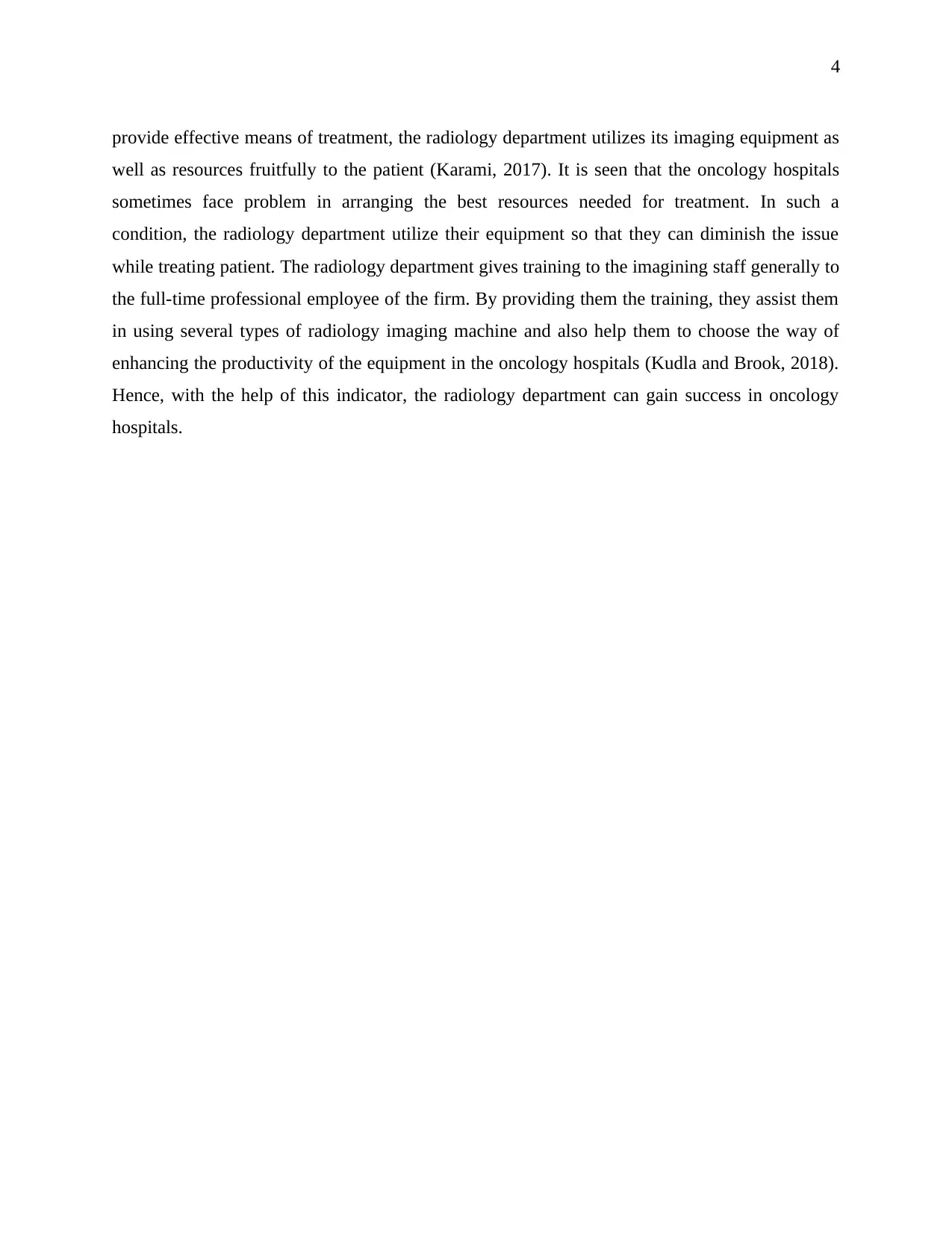
4
provide effective means of treatment, the radiology department utilizes its imaging equipment as
well as resources fruitfully to the patient (Karami, 2017). It is seen that the oncology hospitals
sometimes face problem in arranging the best resources needed for treatment. In such a
condition, the radiology department utilize their equipment so that they can diminish the issue
while treating patient. The radiology department gives training to the imagining staff generally to
the full-time professional employee of the firm. By providing them the training, they assist them
in using several types of radiology imaging machine and also help them to choose the way of
enhancing the productivity of the equipment in the oncology hospitals (Kudla and Brook, 2018).
Hence, with the help of this indicator, the radiology department can gain success in oncology
hospitals.
provide effective means of treatment, the radiology department utilizes its imaging equipment as
well as resources fruitfully to the patient (Karami, 2017). It is seen that the oncology hospitals
sometimes face problem in arranging the best resources needed for treatment. In such a
condition, the radiology department utilize their equipment so that they can diminish the issue
while treating patient. The radiology department gives training to the imagining staff generally to
the full-time professional employee of the firm. By providing them the training, they assist them
in using several types of radiology imaging machine and also help them to choose the way of
enhancing the productivity of the equipment in the oncology hospitals (Kudla and Brook, 2018).
Hence, with the help of this indicator, the radiology department can gain success in oncology
hospitals.
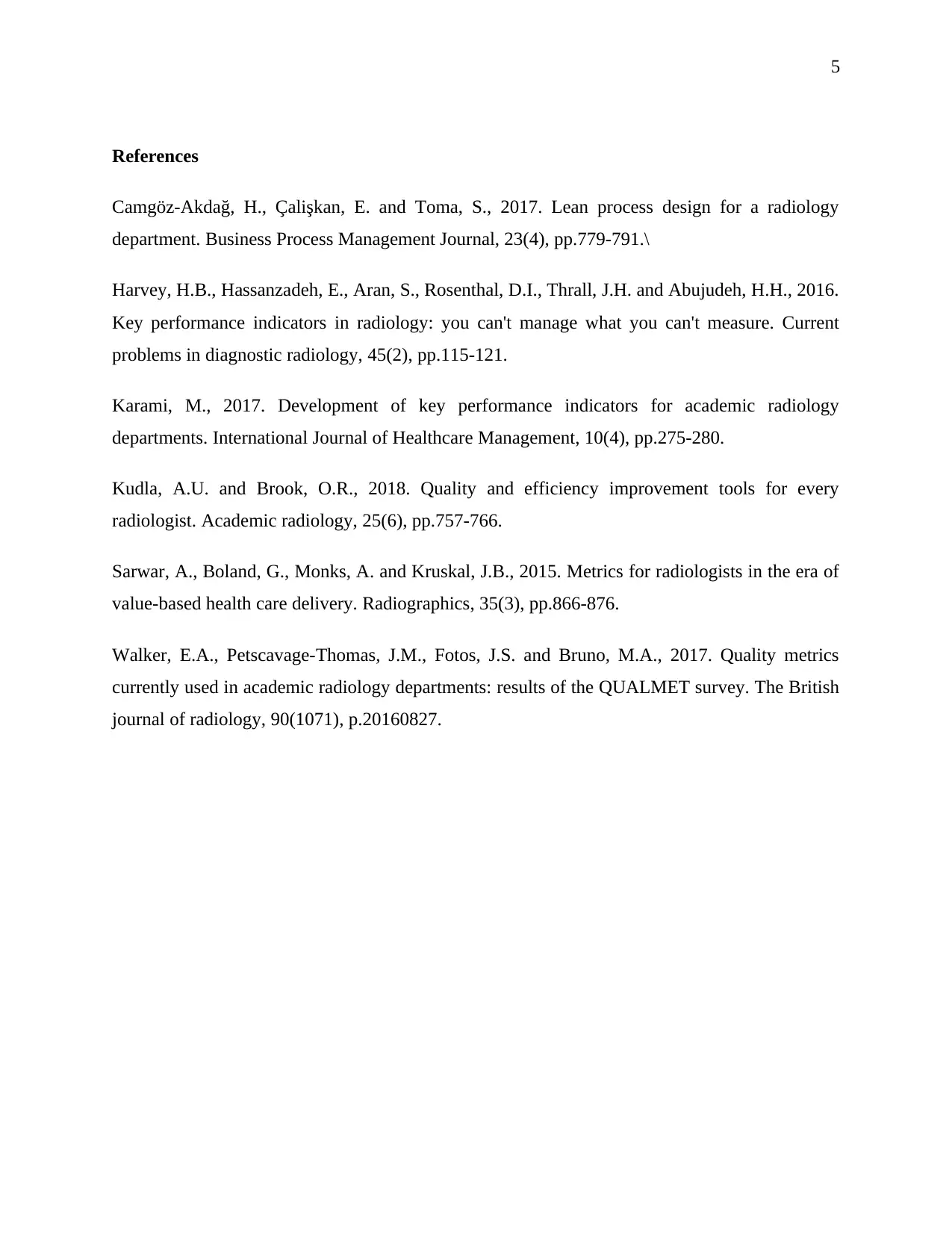
5
References
Camgöz-Akdağ, H., Çalişkan, E. and Toma, S., 2017. Lean process design for a radiology
department. Business Process Management Journal, 23(4), pp.779-791.\
Harvey, H.B., Hassanzadeh, E., Aran, S., Rosenthal, D.I., Thrall, J.H. and Abujudeh, H.H., 2016.
Key performance indicators in radiology: you can't manage what you can't measure. Current
problems in diagnostic radiology, 45(2), pp.115-121.
Karami, M., 2017. Development of key performance indicators for academic radiology
departments. International Journal of Healthcare Management, 10(4), pp.275-280.
Kudla, A.U. and Brook, O.R., 2018. Quality and efficiency improvement tools for every
radiologist. Academic radiology, 25(6), pp.757-766.
Sarwar, A., Boland, G., Monks, A. and Kruskal, J.B., 2015. Metrics for radiologists in the era of
value-based health care delivery. Radiographics, 35(3), pp.866-876.
Walker, E.A., Petscavage-Thomas, J.M., Fotos, J.S. and Bruno, M.A., 2017. Quality metrics
currently used in academic radiology departments: results of the QUALMET survey. The British
journal of radiology, 90(1071), p.20160827.
References
Camgöz-Akdağ, H., Çalişkan, E. and Toma, S., 2017. Lean process design for a radiology
department. Business Process Management Journal, 23(4), pp.779-791.\
Harvey, H.B., Hassanzadeh, E., Aran, S., Rosenthal, D.I., Thrall, J.H. and Abujudeh, H.H., 2016.
Key performance indicators in radiology: you can't manage what you can't measure. Current
problems in diagnostic radiology, 45(2), pp.115-121.
Karami, M., 2017. Development of key performance indicators for academic radiology
departments. International Journal of Healthcare Management, 10(4), pp.275-280.
Kudla, A.U. and Brook, O.R., 2018. Quality and efficiency improvement tools for every
radiologist. Academic radiology, 25(6), pp.757-766.
Sarwar, A., Boland, G., Monks, A. and Kruskal, J.B., 2015. Metrics for radiologists in the era of
value-based health care delivery. Radiographics, 35(3), pp.866-876.
Walker, E.A., Petscavage-Thomas, J.M., Fotos, J.S. and Bruno, M.A., 2017. Quality metrics
currently used in academic radiology departments: results of the QUALMET survey. The British
journal of radiology, 90(1071), p.20160827.
⊘ This is a preview!⊘
Do you want full access?
Subscribe today to unlock all pages.

Trusted by 1+ million students worldwide
1 out of 6
Your All-in-One AI-Powered Toolkit for Academic Success.
+13062052269
info@desklib.com
Available 24*7 on WhatsApp / Email
![[object Object]](/_next/static/media/star-bottom.7253800d.svg)
Unlock your academic potential
Copyright © 2020–2025 A2Z Services. All Rights Reserved. Developed and managed by ZUCOL.


